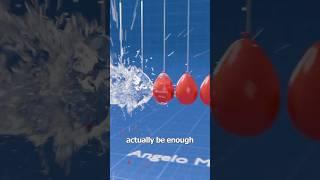
How Many Water Balloons Can Stop A Bullet?
If anyone is interested in the math behind that:
When a bullet enters water, it experiences a sudden and extreme increase in drag force due to water being about 800 to 1000 times denser than air. The drag deceleration can be estimated with the formula a ≈ (1/2) × ρ × Cd × A × v² / m, where ρ is the density of water (~1000 kg/m³), Cd is the drag coefficient (~0.3 for bullets), A is the cross-sectional area, v is the bullet velocity, and m is the bullet mass. Water balloons, typically 5 inches (0.13 m) in diameter, provide discrete segments of dense fluid which rapidly slow bullets through energy dissipation and drag. Slower, heavier handgun bullets like 9mm and .45 ACP retain their structure longer in water, while high-speed rifle rounds such as 5.56 NATO or .308 Winchester often fragment or destabilize quickly due to hydrodynamic pressure. Theoretical stopping distances are based on bullet energy, shape, and the rate of velocity loss in dense fluid. Real-world experiments show that bullets often stop sooner than theory predicts due to fragmentation, tumbling, and variations in balloon spacing. Tests referenced include: MythBusters (Season 3, Episode 10, 2005), FYFD by Nicole Sharp (“Why bullets slow down in water”), National Geographic’s Street Genius (.44 Magnum test), and RangeHot.com’s test of .45 ACP and .357 Magnum with water balloons (https://rangehot.com/rangehot-com-looks-at-the-bullet-proof-balloon-video). Ballistics data sourced from public references for typical muzzle energy and speed of 9mm Luger, .45 ACP, 5.56 NATO, and .308 Winchester cartridges.
When a bullet enters water, it experiences a sudden and extreme increase in drag force due to water being about 800 to 1000 times denser than air. The drag deceleration can be estimated with the formula a ≈ (1/2) × ρ × Cd × A × v² / m, where ρ is the density of water (~1000 kg/m³), Cd is the drag coefficient (~0.3 for bullets), A is the cross-sectional area, v is the bullet velocity, and m is the bullet mass. Water balloons, typically 5 inches (0.13 m) in diameter, provide discrete segments of dense fluid which rapidly slow bullets through energy dissipation and drag. Slower, heavier handgun bullets like 9mm and .45 ACP retain their structure longer in water, while high-speed rifle rounds such as 5.56 NATO or .308 Winchester often fragment or destabilize quickly due to hydrodynamic pressure. Theoretical stopping distances are based on bullet energy, shape, and the rate of velocity loss in dense fluid. Real-world experiments show that bullets often stop sooner than theory predicts due to fragmentation, tumbling, and variations in balloon spacing. Tests referenced include: MythBusters (Season 3, Episode 10, 2005), FYFD by Nicole Sharp (“Why bullets slow down in water”), National Geographic’s Street Genius (.44 Magnum test), and RangeHot.com’s test of .45 ACP and .357 Magnum with water balloons (https://rangehot.com/rangehot-com-looks-at-the-bullet-proof-balloon-video). Ballistics data sourced from public references for typical muzzle energy and speed of 9mm Luger, .45 ACP, 5.56 NATO, and .308 Winchester cartridges.
Комментарии:
How Many Water Balloons Can Stop A Bullet?
Angelo Motion
엔비디아]악재는 여전하다.
모둠채소
Фильм о победителях конкурса «Лучший реализованный проект в области строительства» в 2020 году
Департамент градостроительной политики города Москвы
Установили самый реалистичный паровой 3D электрокамин Dimplex Cassette 1000 (без дров)
Vostok Dekor - ПРЕМИУМ-ТОВАРЫ ДЛЯ ИНТЕРЬЕРА
Третий военно-патриотических слет “Служу Отечеству”
ДОСААФ Ярославской области
No-Bake Granola Bars (Back to School Recipe) Gemma's Bigger Bolder Baking Ep 139
Bigger Bolder Baking with Gemma Stafford
PLAYING AI MINECRAFT... (its crazy)
dakblake
я уверен вы не смотрели этот фильм #фильм #осуждение #кино #кинофильм
KakBuduBogatVrotDam
Probate Process from A to Z for REALTORS
Paul Horn - Probate Attorney and CPA
Duke Ellington in Belgrade, 1971
Esatchmo

![엔비디아]악재는 여전하다. 엔비디아]악재는 여전하다.](https://ruvideo.cc/img/upload/UTkyeEkyQ2ptTEw.jpg)
























